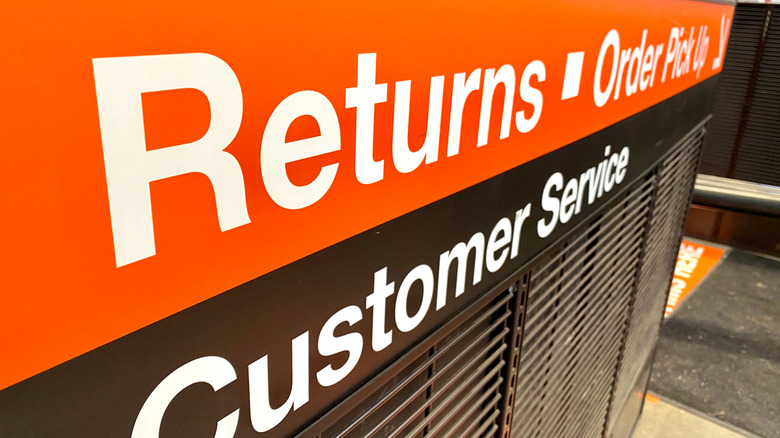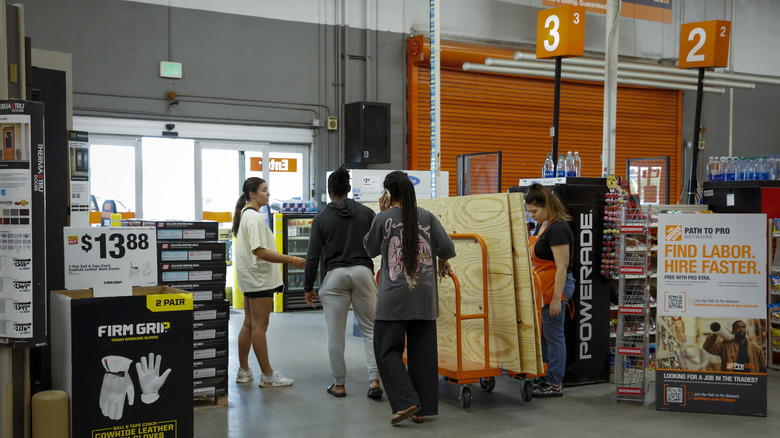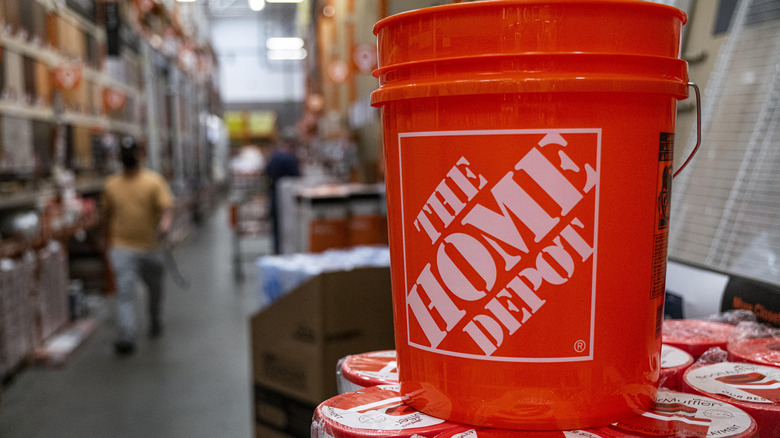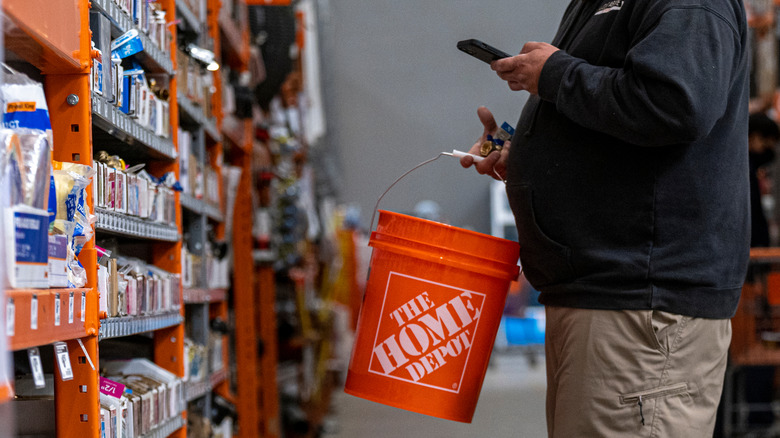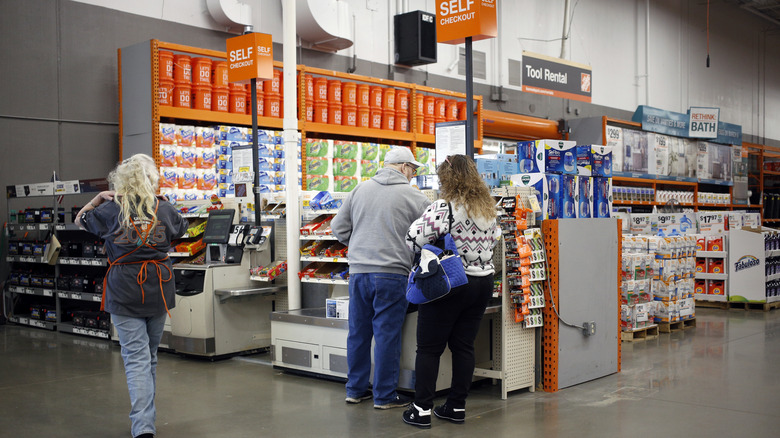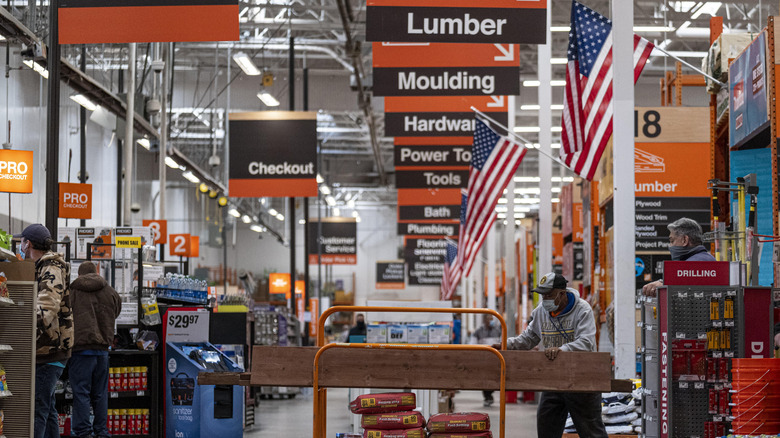Home Depot's Return Policy Explained
It's frustrating when you buy something, only for it not to work when you get home. The product was either packaged defectively, broke after you opened it, or doesn't serve your intended purpose properly. Now you have to determine the seller's return policy. For some stores, this is pretty easy and hassle-free; others have a lengthy process that may not even be worth your time. Fortunately, if you bought this product from Home Depot, its retail return process is straightforward. Per their website, the retailer usually accepts purchased items back without asking questions, which is convenient for shoppers.
However, there are some things you need to know about when it comes to caveats. For example, retailers typically only accept returns for a certain amount of time, which is true of Home Depot as well. To that end, we broke the policy down for you, highlighting the relevant information you need to know.
How long do shoppers have to return items?
According to Home Depot's general return policy, you have 90 days to return most items. However, there are a few exceptions to this rule. For one, this policy presumes you have your ID and a receipt, but if you don't, a Home Depot associate can pull up receipts for credit and debit card purchases made in the past 30 days. Additionally, you also only have 30 days to return furniture, area rugs, gas-powered equipment (including tractors), generators, and consumer electronics (televisions, computers, etc.). The 90-day return policy also includes purchases made at the Home Depot Design Center.
There are a select group of consumers that have an extended return period of 365 days (except for Home Depot Design Center purchases): Those who have a Home Depot Consumer Credit Card, Home Depot Commercial Revolving Charge, or a Home Depot Commercial Account. You also won't need a receipt as the store can locate records dating back one year when purchased with one of these credit cards or accounts.
Items ineligible for return
There are also a few items at Home Depot that are completely ineligible for return. For starters, most custom products can't be returned (like custom-mixed paints). Similarly, discounted "oops" paint can't be brought back either. Home Depot also won't accept custom-ordered blinds. The only exception to this rule is if they were "Guaranteed to Fit," and even then they can only be exchanged (and there's a 15-day window to complete the exchange).
Other items that cannot be returned are flooring, fabric and wallpaper samples, utility trailers, whole house and stationary generators, floral arrangements/cut flowers, and store credit or gift cards. Installation and delivery fees and costs are also non-refundable. Note that you are able to return flammable or hazardous items, but only in-person. You can also return major appliances that are faulty, but only if you report the defect within 48 hours of accepting the delivery or picking the item up.
Frequently asked questions
All that Home Depot's website says is required for returns is a valid ID, a receipt, and the item, but they never specify how or even if it needs to be packaged. They also don't state if your item has to be unopened to be eligible for returns. According to RVandPlaya, you can usually return opened items to Home Depot, but the final decision is up to the manager. You can increase your chances for a full refund by bringing the item's original packaging and your receipt. However, this is assuming that the item has not been heavily used, if at all. The manager may just offer you store credit or an exchange instead of a full refund, or deny it altogether.
Some stores have restocking fees tacked on with their returns which you should keep in mind to avoid confusion or shock when completing yours. Note that Home Depot does have a restocking fee of 15%, but only for special order returns or cancellations.
How are refunds processed?
Nowhere in Home Depot's return policy does it specify if items marked on sale or clearance are excluded. To that end, it's safe to assume they're likely eligible for returns as long as the item is either in its original packaging or only lightly used, and you have your receipt and a valid ID. However, be aware that some customers have reported that Home Depot does not allow returns for clearance/yellow tagged plants (via Rather Be Shopping).
In general, Home Depot will refund you via the original payment method (if you paid with cash, you'll receive cash, if you paid with card, you'll get reimbursed the balance, etc.). Gift card and store credit refunds are issued as store credit. If you get refunded via one of these methods, you'll receive your credit immediately. If you are paid back on a card, Home Depot says the credit will be issued either as soon as the item is returned in store, or received and processed in a warehouse if returned by mail. However, it could take two to 10 business days for the credit to process and show up in your bank account or on your credit card statement.
Home Depot vs. Lowe's return policy
Home Depot and Lowe's are two of the most popular home improvement stores and have pretty similar return policies; however, there are some variations between the two retailers. According to Lowe's, they also have a general 90-day return policy, which is extended to 365 days with a Lowe's Commercial Account, Lowe's Business Advantage, Lowe's Advantage Card, or Lowe's Business Rewards. If you don't have your receipt, you can also ask a Lowe's associate to locate the record in their system, though they don't guarantee it will be found.
Lowe's also limits its return policy to 30 days for select items similar to Home Depot, and 48 hours for any major appliances. However, if the item is unopened and sealed, you have 30 days to return it, which is a little more lenient than Home Depot's policy. Lowe's restocking fee for special orders is 20%, and their credit returns may take as long as 15 days to be issued.
